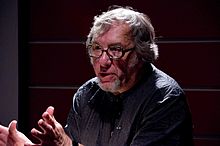Joel-Peter Witkin
Joel-Peter Witkin (born September 13, 1939 in Brooklyn , New York City ) is an American photographer .
Life
Witkin, born in Brooklyn in 1939, grew up as the son of a Jewish father and a mother of Roman Catholic faith; however, his parents divorced early because they could not overcome their religious differences. He attended middle school at Saint Cecelia in Brooklyn and later went to Grover Cleveland High School. He worked as a war photographer in the Vietnam War from 1961 to 1964 . In 1967 he decided to work as a freelance photographer and was the official photographer of the company " City Walls Inc. ". He later attended the " Cooper Union " in Brooklyn where he studied sculpture and graduated in 1974 with a Bachelor of Fine Arts . In the same year Columbia University granted him a scholarship. In 1975 Witkin began studying art and art history at New Mexico University in Albuquerque . He finished his studies in 1981 with a Master of Fine Arts .
Witkins works often deal with death , corpses (or parts thereof) and various outwardly extraordinary people such as short stature people , transsexuals , hermaphrodites and physically deformed people. His complex tableaux vivants often show religious scenes or recreate (famous) classical images. Due to the transgressive nature of his works, he was often accused of exploiting his models.
He states that his ideas and visual visions were inspired by an event in his childhood. A car accident in which a girl was beheaded happened right in front of his parents' house. Furthermore, the religious tensions of his parents had shaped him and also represented an influence on his works.
He names Giotto di Bondone as his favorite artist . Witkins work is clearly influenced by surrealism , especially by Max Ernst . His photographic techniques are based on those of the early daguerreotype and the works of EJ Bellocq .
Witkin uses an intuitive technique in the production of the picture, he works the negative directly with scratches or bleaches or tones the picture afterwards. These experiments used Witkin after a Ambrotype from the 19th century had come, showing a woman whose lover was scraped from the image.
literature
- Eugenia Parry: Joel-Peter Witkin , Berlin (Phaidon) 2007. ISBN 978-0-7148-4787-0 .
- Stefanie Diekmann: Mythologies of Photography. Abriß zur discourse history of a medium , Munich (Wilhelm Fink) 2003. 978-3-7705-3777-8 (The monograph is an examination of Witkins text Revolte Against the Mystical .)
Web links
- Works by Witkin at zonezero.com
- Works by Witkin at art-forum.org
- Joel-Peter Witkin: a saint in the morgue
- Witkins biography on the National Gallery of Art homepage
Individual evidence
| personal data | |
|---|---|
| SURNAME | Witkin, Joel-Peter |
| BRIEF DESCRIPTION | American photographer |
| DATE OF BIRTH | September 13, 1939 |
| PLACE OF BIRTH | New York City |
